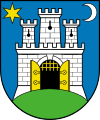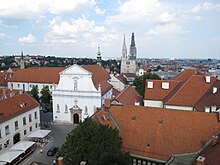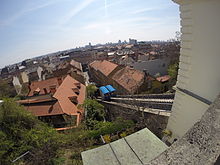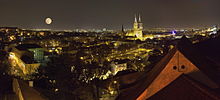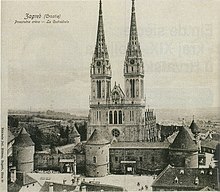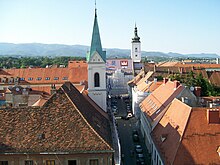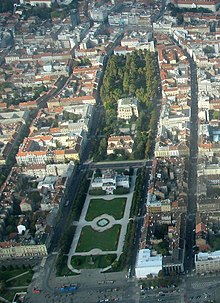Zagreb
| Zagreb | |||
|
|||
|
|
|||
| Basic data | |||
|---|---|---|---|
| State : |
|
||
| County : | City of Zagreb | ||
| Height : | 158 m. i. J. | ||
| Area : | 641.355 km² | ||
| Residents : | 820,678 (November 1, 2018) | ||
| Agglomeration : | 1,228,941 (November 1, 2018) | ||
| Population density : | 1,280 inhabitants per km² | ||
| Telephone code : | (+385) 01 | ||
| Postal code : | 10,000 | ||
| License plate : | ZG | ||
| Structure and administration (status: 2013, cf. ) |
|||
| Community type : | City with functions of a county | ||
| Structure : | 17 districts 216 municipalities (former) 71 settlements |
||
| Lord Mayor : | Milan Bandić (MB 365) | ||
| Postal address : | Trg Stjepana Radića 1 / III 10 000 Zagreb |
||
| Website : | |||
 The Cathedral of Zagreb |
|||

Zagreb [ˈzaːgrɛb] ( German outdated Agram ; Hungarian Zágráb ) is the capital and largest city of Croatia . The city of Zagreb itself also functions as a county . The vicinity of the city is separated from it by the Zagreb County , whose administrative seat is also the city of Zagreb. A Catholic archbishop ( Archbishopric of Zagreb ), the Croatian Academy of Sciences and Arts, and important administrative and military authorities reside in Zagreb . As a commercial and financial center, the city has national and regional importance.
name of the city
The name Zagreb probably comes from zagrabiti "(to draw water)". According to other sources, Zagreb means “behind the mountain” (Croatian za bregom ) or “behind the dam” (za grebom) .
population
Zagreb is the only city in Croatia that has more than a million inhabitants (with suburbs). According to the 2011 census, 790,017 people lived in the city. In the surrounding area, in which there are suburbs and nearby smaller towns such as Dugo Selo , Samobor , Velika Gorica or Jastrebarsko , 317,606 people lived. 93.14% of them were Croatians , 2.22% Serbs, 1.03% Bosniaks and 2.31% belonged to another minority, including Hungarians, Slovenes, Czechs and Ukrainians.
Approx. In 2011, 87% of Zagreb residents were professing Catholics, 2% Orthodox Christians, 1% Muslims, 4% atheists and 4% agnostics. 2% named another religious community.
| year | surface | Population (according to the respective breakdown) | Population (according to today's structure) | annotation |
|---|---|---|---|---|
| 1368 | 2,810 | According to household census | ||
| 1742 | 5,600 | According to household census | ||
| 1805 | 7,706 | Census without priesthood and nobility | ||
| 1850 | 16,036 | |||
| 1857 | 16,657 | 48,266 | ||
| 1869 | 19,857 | 54,761 | ||
| 1880 | 30,830 | 67,188 | ||
| 1890 | 3.33 | 40,268 | 82,848 | |
| 1900 | 64.37 | 61.002 | 111,565 | |
| 1910 | 64.37 | 79,038 | 136.351 | |
| 1921 | 64.37 | 108,674 | 167.765 | |
| 1931 | 64.37 | 185,581 | 258.024 | |
| 1948 | 74.99 | 279.623 | 356,529 | |
| 1953 | 235.74 | 350,829 | 393.919 | |
| 1961 | 495.60 | 430.802 | 478.076 | |
| 1971 | 497.95 | 602.205 | 629.896 | |
| 1981 | 1,261.54 | 768,700 | 723.065 | |
| 1991 | 1,715.55 | 933.914 | 777.826 | |
| 2001 | 641.36 | 779.145 | 779.145 | |
| 2011 | 641.36 | 790.017 | 790.017 |
Remarks
- ↑ The information relates to the administrative structure valid at the time of the census and the territory defined as "City of Zagreb" at the time.
- ↑ The information relates to the current administrative structure (text of the law published in Narodne Novine No. 10 of January 30, 1997). The dates of the respective censuses were broken down to the current territory of the city of Zagreb.
history
The name Zagreb was mentioned for the first time in 1094, as in personal union Hungarian-Croatian King Ladislaus I the Zagreb diocese founded. The city developed from the two settlement centers Kaptol (episcopal city) in the east and Gradec (upper town) in the west. Kaptol was the city of the clergy , in which the bishop and canons of the Zagreb diocese resided since the 11th century. In the upper town on the neighboring Bergsporn to the west, merchants and craftsmen settled. Conflicts of interest between the two settlements repeatedly led to disputes.
In the 13th century, Southeast Europe suffered devastating pillage by the Tatars (Mongolian tribes). Béla IV. , King of Croatia and Hungary from 1235 to 1270, organized the defense from Gradec. In gratitude for their support, he gave the inhabitants of Gradec the Bulla Aurea in 1242 , a symbol of freedom and independence. This document made Gradec a free royal city; a period of economic boom began. Palaces, churches and fortifications were built based on Central and West European models.
Zagreb was first mentioned as Croatia's capital in 1557 . The city was in the hinterland of the military border established in 1583 to ward off the Turks . In 1669 a Jesuit academy (Neoacademia Zagrabiensis) was founded; it became a forerunner of the University of Zagreb, founded in 1874 .
Later, the lower town (Donji grad) slowly developed in the south of the two mountain settlements , initially around the later main square, today's Ban Jelačić Square, which was laid out in the 17th century .
18th and 19th centuries
From 1756 to 1776 Varaždin was the capital of Croatia. In 1850 the cities of Gradec and Kaptol were united to form the city of Zagreb and connected to the lower town. The lower town grew rapidly. A severe earthquake in 1880 caused considerable damage, but also enabled the city to modernize and develop dynamically.
Kaptol is still the center of the Catholic Church and spiritual life in Croatia. Gradec, now called Upper Town, became the political and administrative center. Economic, scientific and cultural life pulsates in the lower town with its many magnificent buildings from the late 19th century. Zagreb was the seat of Zágráb County at the time of the Kingdom of Hungary .
Interwar period
On October 29, 1918, the Croatian Parliament in Zagreb decided to terminate all legal relations between Croatia and the Austro-Hungarian monarchy . On the same day the state of Slovenes, Croats and Serbs was founded with Zagreb as the capital. To commemorate this, an alley near St. Mark's Square in Gornji Grad was called "Street of 29th X. 1918".
On December 1, the new state united with the Kingdom of Serbia to form the Kingdom of Serbs, Croats and Slovenes , which was later renamed the Kingdom of Yugoslavia. The Serbian King Peter I became head of state . Four days later, the residents of Zagreb demonstrated against the state government on Ilica Street. The royal Serbian gendarmerie shot 20 people who became known as "December victims".
During the Kingdom of Yugoslavia, Zagreb was the economic and cultural center and the second largest city in the country. In about twenty years the population increased by a factor of 2.5 due to immigration from poor villages. Radio Zagreb broadcast the first broadcast on May 15, 1926 . She started with the words “Halo, halo! Ovdje Radio Zagreb! ”(German:“ Hello, hello! Radio Zagreb here! ”).
Second World War
In the spring of 1941, the Wehrmacht captured the Kingdom of Yugoslavia and the Kingdom of Greece within a few weeks . Zagreb was the capital of the Independent State of Croatia , a vassal state of the Axis powers , until the end of World War II . Before the World War there were around 12,000 Jews in Zagreb, after which there were only a few thousand. Today there are 3000 people of the Jewish faith in all of Croatia; 2000 of them belong to the Jewish community of Zagreb.
Capital of the Yugoslav republic of Croatia
On May 8, 1945, Zagreb was occupied by the Yugoslav People's Liberation Army under Tito . As the Socialist Republic of Croatia, Croatia was incorporated into the Federal People's Republic of Yugoslavia , later the Socialist Federal Republic of Yugoslavia .
In 1970 and 1971, Zagreb was the center of resistance against the communist government. There were demonstrations against the policies of the Belgrade central government. The Croatian Spring was crushed and ended with mass arrests.
On September 10, 1976, a Yugoslav and a British aircraft collided near Zagreb . 176 people (including numerous Germans) died.
In 1987 the Universiade took place in Zagreb . The city hosted the 1990 Eurovision Song Contest in the “Vatroslav Lisinski” concert hall because the year before that, the Croatian band Riva from Zadar won with the song Rock Me .
Croatian independence and Croatian war
After the fall of the wall , the Eastern bloc collapsed . In March 1991, the Yugoslav People's Army started the Croatian War . On June 25, 1991, the Croatian Parliament declared Croatia's independence from Yugoslavia and Zagreb as the country's capital. In September 1991 massive fighting began, including the battle for Vukovar . On October 7, 1991, a JNA fighter plane fired an air-to-surface missile into the Zagreb government building where President Tuđman and other members of the government were staying. Nobody was seriously injured. Zagreb was then overcrowded with refugees from Eastern Slavonia , especially from the city of Vukovar . On October 8, 1991, Croatia's government officially implemented the independence it had declared after a referendum .
On May 2 and 3, 1995, when the rockets hit Zagreb, cluster bombs hit the city center. Seven people died and 214 were injured.
900 year celebration
In 1994 Zagreb's 900th anniversary was celebrated. Pope John Paul II came to Zagreb and celebrated a mass on September 11th at the Zagreb Riding School with more than a million believers.
21st century
On the morning of March 22, 2020, an earthquake with a magnitude of 5.4 M w occurred , the epicenter of which was a few kilometers north of the city. Numerous buildings were badly damaged, especially in the old town. Part of the southern spire of the cathedral broke off.
geography
Zagreb is 122 meters above sea level in the continental area of Central Croatia at the foot of the Medvednica Mountains to the north . It lies at the intersection between Central and Southern Europe . Zagreb stretches on both sides of the Sava , the largest rivers in Slovenia and Croatia. It is located in the southwest of the Pannonian Plain in an area that is also called Hrvatsko Prigorje . The distance to the Adriatic Sea is about 170 kilometers.
climate
| Zagreb | ||||||||||||||||||||||||||||||||||||||||||||||||
|---|---|---|---|---|---|---|---|---|---|---|---|---|---|---|---|---|---|---|---|---|---|---|---|---|---|---|---|---|---|---|---|---|---|---|---|---|---|---|---|---|---|---|---|---|---|---|---|---|
| Climate diagram | ||||||||||||||||||||||||||||||||||||||||||||||||
| ||||||||||||||||||||||||||||||||||||||||||||||||
|
Average monthly temperatures and rainfall for Zagreb
Source: Meteorological and Hydrological Service Croatia ; Duration of sunshine, humidity: wetterkontor.de
|
|||||||||||||||||||||||||||||||||||||||||||||||||||||||||||||||||||||||||||||||||||||||||||||||||||||||||||||||||||||||||||||||||||||||||||||||||||||||||||||||||||||
politics
Zagreb is the capital and the seat of government of the Republic of Croatia . The Croatian parliament, the Sabor , also meets in Zagreb . The government district is located in Gornji Grad (Upper City), the old town of Zagreb. Milan Bandić was elected Mayor of Zagreb for the sixth time in June 2017. The strongest faction in the city council is the Social Democratic Party of Croatia .
economy
In 2004 about 30% of the Croatian gross national product was generated in Zagreb. In 2011, Zagreb contributed a third of the gross national product. It is the most important business location in Croatia.
Important industries in Zagreb are the pharmaceutical industry , electrical engineering , trade and tourism .
In the south-eastern part of the city lies the largest industrial area Žitnjak.
The Croatian National Bank and the only Croatian stock exchange are based in Zagreb.
Many companies such as B. the oil and gas company INA have their headquarters in Zagreb. In the west of the city are the pharmaceutical company Pliva , the electrical engineering company Končar Group and Ericsson-Tesla .
Visitors from neighboring EU countries discovered Zagreb as a shopping city: there are shopping centers on the periphery in the east and west of the city; In the center of Zagreb there is the main shopping street Ilica with numerous traditional craft shops such as cobblers , hat makers , leather bag shops , coopers , boutiques and jewelers .
The Zagreb Fair ( Zagrebački Velesajam ) is the most important fair location in the region.
The German-Croatian Chamber of Commerce and Industry is also based in Zagreb .
Traffic and transportation
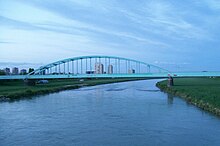
Zagreb is an intermediate station of the Pan-European Transport Corridor X , both in the road and in the rail sector .
railroad
Zagreb is an important hub in the Croatian Railways network . The main railway station (Glavni kolodvor), which is important for passenger traffic, is located south of the city center on König-Tomislav- Platz . International direct connections in daytime traffic are among others to Ljubljana (2:30 hours), Budapest (6 hours), Belgrade (6 hours), Vienna (6 hours) and Munich ( through coaches , approx. 9 hours), as well as by night train (EN) offered to and from Munich. Other travel destinations currently require a change in Villach .
In intra-Croatian traffic, Split can be reached in six hours. In local rail passenger transport , in addition to the main train station, the western train station (Zapadni kolodvor) to the west of the city center and the Zagreb Klara station south of the Sava are served. Zagreb also has an urban railway system similar to that of the S-Bahn , with several inner-city stops. There is also a large marshalling yard south of the Sava .
Street
A well-developed motorway network connects Zagreb with the port cities of Rijeka and Split and the Dalmatia region ( A1 ) as well as with the eastern Croatian region of Slavonia ( A3 ), as well as Slovenia ( A2 ) and Hungary ( A4 ).
air traffic
Zagreb has an international airport , located about 20 km southeast of the city center in the area of Pleso . The IATA airport code is ZAG .
Public transport and long-distance buses
The city's public transport is mainly operated by the municipal transport company Zagrebački električni tramvaj (ZET). ZET operates the Zagreb tram and local city bus services. There is also a funicular in Zagreb . In the past there was also a gondola lift up to Sljeme.
The main train station is in the center of the city on King Tomislav Square.
To the southeast of the city center is the bus station (Autobusni kolodvor Zagreb) on Avenija Marina Držića . Almost all parts of Croatia and numerous cities in Europe are regularly approached from here.
Science and Research
The highest scientific institution in Croatia is the Croatian Academy of Sciences . The University of Zagreb was founded on September 23, 1669 and is one of the oldest universities in East Central Europe . The faculty buildings are located in several parts of the city; the Zagreb University Library, which belongs to the University of Zagreb , has been located in a district outside the center since 1995. The Zagreb Academy of Art and the Zagreb Academy of Music enjoy an international reputation.
Other universities are the Health University in Zagreb, the Social Science University in Zagreb and the Technical University in Zagreb.
The Ruđer Bošković Institute, founded in 1950, is the largest interdisciplinary institute in Croatia and in 2005 employed a total of 200 scientists.
media
A selection of the newspapers and magazines published in Zagreb:
- Večernji list , daily newspaper
- Jutarnji list , daily newspaper
- 24 sata , daily newspaper
- Nacional , weekly newspaper
- Dnevnik , business newspaper
In the 19th and 20th centuries there were also two German-language daily newspapers for Zagreb, the Agramer Tagblatt and the Agramer Zeitung .
Attractions
Kaptol (episcopal city)
The district on a mountain spur around the cathedral was formed with the foundation of the Zagreb diocese in the 11th century. Not only the bishop resided here, but the spacious courts of the canons stretched north on both sides of the main street. Outside in the south and north, servants and craftsmen settled and over time formed two suburbs. The core facility was provided with a still legible wall in the 15th century.
- The Cathedral of Zagreb (Assumption of the Virgin Mary, formerly Stefansdom; Katedrala svetog Stjepana ): The symbol of the city is the cathedral, which was newly built in the 13th century and later changed. Around 1510 it was surrounded by a massive artillery fortification with corner rondelles. On its forecourt, which today bears the name of the Kaptol , is the Madonna fountain with four golden angels and a column on which a golden statue of the Virgin Mary is enthroned.
- The Church of St. Francis (Crkva svetog Franje) : The church of the Franciscan monastery, founded in the 13th century, impresses with many beautiful stained glass windows. It was extensively renovated around 1900. In the monastery next door you will find the Sveti Franjo chapel.
- The Marienkirche (Crkva svete Marije) : The church was built as a sacred building of a Cistercian monastery. It is equipped with baroque altars. Otherwise, baroque and Gothic style elements mix. It is located on the west side of the Dolac market.
- The Archbishop's Palace (Nadbiskupska palača) : The Bishop's Palace stretches on three sides around the Sveti Stjepana Cathedral.
- The former canons' mansions line the main street.
- The vegetable or green market (Dolac) : Cheese, fruit, vegetables as well as meat, sausage and baked goods have been on sale at the central and largest market in the city of Zagreb since 1926. Coming from Ban Jelačić Square, it can be reached via stairs along the “flower market”.
- The Ban Jelačić Square (Trg bana Jelačića) : This central square between the upper and lower town was only created as a new market square in the 17th century. He was in the 19th century by Josip Jelačić named (Josip Jelacic Bužimski) . He was a general and ban from Croatia , also k. &. K. Feldzeugmeister and commander of the Maria Theresa Order and is considered a Croatian national hero. This central square was called "Republic Square" from the end of World War II until 1991, before Croatia's independence. Because of its central location, the square is often used as a starting point for sightseeing and excursions. Ban Jelačić Square is a large pedestrian zone where only trams, buses and taxis are allowed to drive. The city's business and banking center is also located here. The funicular , which connects the upper and lower towns , can be reached from the Ilica pedestrian zone to the west of the square .
Gornji Grad (Upper Town)
The upper town to the west of the cathedral mountain, planned in the 13th century on older settlement sites, is characterized by a closed historical development, which today is particularly characterized by the architecture of the baroque and historicism . The city wall with its four gates, which was built in the 13th century, is still clearly legible. Impressive aristocratic palaces alternate with smaller, single-storey properties owned by citizens, craftsmen and merchants.
- The St. Mark's Church ( Crkva svetog Marka ) is the old parish church of Gornji Grad and was probably first created in the 13th century. The current building was built in the last quarter of the 14th century as a three-aisled hall church. In 1866 and 1882 the church was completely renovated. The roof with the two coats of arms dates from 1880. It impresses with a unique roof tile image in the form of two coats of arms. On the left is the coat of arms of Croatia, Dalmatia and Slavonia , on the right the city coat of arms. Sculpture can be seen inside the building. Much of it comes from the well-known Croatian sculptor Ivan Meštrović .
- The Banal Court ( Banski dvori ): It was once used as the seat of the Viceroy ( Bans ) in Croatia . The Ban Palace, built in the 17th century, is now the seat of government.
- The Parliament Building ( Sabor ): The Croatian Parliament Building was built in 1908 and is located opposite the Ban Palace on St. Mark's Square (Markov trg) , on which St. Mark's Church stands. The Croatian Bane once resided in this former palace.
- The Lotrščak Tower (Croatian: Kula Lotrščak ): The tower dates from the 13th century and is located in the immediate vicinity of the mountain station of the cable car . A cannon shot is fired here every day at 12 noon. Below the tower, the rack railway transports passengers from the upper town to the lower town and vice versa.
- The stone gate ( Kamenita vrata ): Of the former city fortifications from the 13th century, only the "stone gate" remains. Once upon a time, five city gates led into Gornji Grad . A fire destroyed most of the neighboring houses in 1731, with only one picture of Mary with baby Jesus at the gate remaining undamaged, according to legend. As a result, the stone gate was converted into a small chapel, which still serves as a place of prayer for believers today.
- The Zagreb City Museum - Muzej Grada Zagreba : From the former nunnery of St. Clare, a former granary, and a tower from the 12th century, the city museum was created on the northern edge of the Gradec district. In this museum u. a. Maps, cityscapes, coats of arms, uniforms and paintings on display.
Donji Grad (Lower Town)
The lower town emerged mainly from the middle of the 19th century when the settlement of Zagreb expanded into the plain to the south. The beautiful area is characterized by a large number of high-quality and well-preserved buildings of historicism (around 1860 to 1900) and Art Nouveau and also has some remarkable projects of architectural modernism .
- The Green Horseshoe (Zelena potkova) : It was created by the architect Milan Lenucci using older structures from around 1870 and connects the squares and green areas of the urban center to form an impressive overall figure. As in Vienna's Ringstrasse, there are representative public buildings, primarily in the historicist style .
- The Croatian National Theater in Zagreb (Hrvatsko narodno kazalište) : It is the western head of the Zagreb Green Horseshoe. The building was designed by the Viennese architects Ferdinand Fellner and Hermann Helmer and completed in 1895.
- The Archaeological Museum (Arheološki muzej) : It shows mainly objects from Croatia. It's at the end of the Green Horseshoe. The Egyptian and numismatic pieces are particularly valuable. In the museum there is an Egyptian mummy and the world's longest extant text in Etruscan language . A collection of Greek vases is also worth mentioning.
- The Art Pavilion ( Umjetnički paviljon ), opened in 1898, is an international art and exhibition hall for contemporary art.
- The Folk Art Museum : It is issued by the Croatian crafts. It's on the left leg of the green horseshoe.
- The Mimara Museum (Muzej Mimara) : The Mimara Museum shows the gifts of the entrepreneur and restorer Ante Topić Mimara and his wife. The archaeological department, a sculpture collection and a number of paintings are outstanding .
- The Botanical Garden (Botanički vrt) : It lies in the junction between the two legs of the Zagreb Green Horseshoe and is closed from November to April. The park is about 50,000 m². Around 10,000 plant species thrive here, including around 1,800 exotic plants from all over the world, but mainly from Asia. You can stroll along beautifully landscaped paths between conifers, artificial bodies of water, pavilions and greenhouses of the university and enjoy the many-sided beauty of the trees, bushes, flowers and the aquatic plants grown in special ponds. In 2000 the park was completely renovated, as some of the trees were infested with vermin.
- The Mirogoj cemetery is located outside the city center : a bus service runs from Kaptol to the cemetery at the foot of the Medvednica Mountains, about 4 kilometers away . Apart from the graves of important Croatians, the two arcades are structurally prominent.
Parks
- The monument of King Tomislav : In 925 Tomislav was crowned the first king of Croatia in Tomislavgrad (reign 910–928) . In his honor there is an equestrian statue on Tomislav Trg in a small park in the immediate vicinity of Zagreb's main train station.
- Zrinski Square (Trg Nikole Šubića Zrinskog , coll. Zrinjevac) : The end of Zagreb's “Green Horseshoe” is the park with a pavilion in the middle of the park and is located on Praška Street. The pavilion is used for artistic events in summer. There is a weather station at the north end of the park. At the south entrance you can find several busts of historically important personalities.
- Maksimir Park (Park Maksimir) : This park, created in 1794, is the largest in southern Europe and also houses the Zagreb Zoological Garden , oak forests, idyllic lakes and meadows. The park is in the east of the city.
- Dotrščina Memorial Park , memorial
Other sights
- Museum of Contemporary Art (Muzej suvremene umjetnosti)
- The Importanne Centar is a large shopping center in the heart of the city. It extends over an area of 10,000 m².
- At 92 m, the Cibona Tower is one of the tallest buildings in the city.
- The Regent Esplanade is one of the legendary buildings in Zagreb and has almost the same status with the city's residents as the cathedral or the national theater. In 1925, the hotel made Zagreb an important stop on the Orient Express . Famous personalities such as Charles Lindbergh , Josephine Baker and Elizabeth Taylor have been guests here. After a lengthy renovation, it was reopened in 2004.
- Zagreb TV tower
- At 97.8 m, the Eurotower is the tallest skyscraper in the city.
- In the immediate vicinity of the city is the hill country of Zagreb, the Medvednica . The Medvednica is a wooded mountain range; the highest point is the Sljeme (1032 m). A cable car runs between the outskirts and the summit. Sights include the Veternica Cave , where prehistoric traces of life have been found, and the medieval Medvedgrad Castle .
Regular cultural events
- Documentary Film Festival Zagrebdox
- International competition for young conductors Lovro von Matačić
- International theater festival of the new Eurokaz theater
- Zagreb Film Festival
- Jewish Film Festival Zagreb
- Zagreb Pride
- Chamber music festival Zagrebački međunarodni festival
Organizations
The Zagreb Film studio is located in Zagreb . It has produced more than 600 animated films since 1953, won over 400 international awards (including an Oscar ) and founded the Zagreb School with its unique style .
Townships
The city districts (Croatian Gradski četvrti ) in alphabetical order, with the population from 2011 in brackets, are:
| No. | district | surface | Pop. (2011) | Former municipalities |
|---|---|---|---|---|
| 1. | Donji degree | 3.016 km² | 37,024 pop. | "Andrija Medulić", "August Šenoa", Cvjetni trg, "Hrvatski narodni vladari", "Knez Mislav", "Kralj Petar Svačić", "Kralj Zvonimir", "Matko Laginja", Mimara, "Nadbiskup Antun Bauer", "Pavao Šubić ”,“ Petar Krešimir IV ”,“ Petar Zrinski ”, Zrinjevac |
| 2. | Gornji Grad-Medveščak | 10.125 km² | 30,962 pop. | "August Cesarec", Gornji grad , Gupčeva zvijezda, "Ivan Kukuljević Sakcinski", Kraljevac, Medveščak, Nova Ves, Petrova, Ribnjak, "Stjepan Radić", Šalata, Tuškanac, Voćarska |
| 3. | Trnje | 7.365 km² | 42,282 pop. | Cvjetnica, Cvjetno naselje, Kanal, Marin Držić, Martinovka, Miramare, Poljane, Savski Kuti, Sigečica, Staro Trnje, Trnjanska Savica , Trnje, Veslačko naselje |
| 4th | Maksimir | 14.349 km² | 48,902 pop. | Bukovac, "Dinko Šimunović", Dobri dol, Dotrščina, "Eugen Kvaternik", Kozjak, Maksimir, Maksimirska naselja, Mašićeva, Remete, Ružmarinka |
| 5. | Peščenica - Žitnjak | 35.295 km² | 56,487 pop. | Borongaj Lugovi, "Bruno Bušić", Donje Svetice, Ferenščica, Folnegovićevo naselje, "Hrvatski književnik Mile Budak", Ivanja Reka, Kozari Bok, Kozari Putevi, Peščenica, Petruševec, Resnik, Savica-Šanci, Volitukomere |
| 6th | Novi Zagreb-istok | 16.544 km² | 59,055 pop. | Buzin, Dugave, Hrelić, Jakuševec, Sloboština, Sopot, Središće, Travno, Utrine, Veliko Polje, Zapruđe |
| 7th | Novi Zagreb-zapad | 62.594 km² | 58,103 pop. | Blato, Botinec, Čehi, Hrašće, Hrvatski Leskovac, Ježdovec, Kajzerica, Lučko, Mala Mlaka, Odra, Remetinec, Savski Gaj, Siget, Sveta Klara, Trnsko |
| 8th. | Trešnjevka-sjever | 5.828 km² | 55,425 pop. | "Antun Mihanović", Ciglenica, "Dr. Ante Starčević ”, Ljubljanica,“ Nikola Tesla ”, Pongračevo, Rudeš, Samoborček,“ Silvije Strahimir Kranjčević ”, Stara Trešnjevka |
| 9. | Trešnjevka-jug | 9.836 km² | 66,674 pop. | Horvati-Srednjaci, Gajevo, Jarun , Knežija, Prečko, Vrbani |
| 10. | Črnomerec | 24.327 km² | 38,546 pop. | "Ban Keglević", "Bartol Kašić", Gornja Kustošija, Kustošija-centar, Jelenovac, Medvedgrad, Sveti Duh, Šestinski dol-Vrhovec |
| 11. | Gornja Dubrava | 40.277 km² | 61,841 pop. | Branovec-Jalševec, Čučerje, Dankovec, Dubec, Dubrava-središte, Gornja Dubrava, Granešina, Granešinski Novaki, Klaka, Miroševec, Novoselec, Oporovec, Poljanice, Stari Retkovec, Studentski grad, Trnovčica, Zeleni brijeg |
| 12. | Donja Dubrava | 10.823 km² | 36,363 pop. | Čulinec, Donja Dubrava, "Ivan Mažuranić", Novi Retkovec, Resnički Gaj, Poljanice, Stari Retkovec, "30. svibnja 1990. “, Trnava |
| 13. | Stenjevec | 12,180 km² | 51,390 pop. | Gajnice, Malešnica, “Matija Gubec”, Stenjevec, Špansko , Vrapče-jug |
| 14th | Podsused-Vrapče | 36.049 km² | 45,759 pop. | Gornji Stenjevec, Gornje Vrapče, Perjavica-Borčec, Podsused, Vrapče-centar, Gajnice, Stenjevec |
| 15th | Podsljeme | 60.116 km² | 19,165 pop. | Gračani, Markuševec, Mlinovi, Šestine, Vidovec |
| 16. | Sesvete | 165.238 km² | 70,009 pop. | Adamovec, Belovar, Blaguša, Cerje-Sesvete, Dobrodol, Dumovec, Đurđekovec, Gajec, Gajišće, Glavnica Donja, Glavnica Gornja, Goranec, Jelkovec, Jesenovec, Kašina, Kašinska Sopnica, Kašina, Kašinska Sopnica, Kujeve-Sopnica, Kobilčanakž Moravče, Novo Brestje, Paruževina, Planina Gornja, Planina Donja, Popovec, Prekvršje, Prepuštovec, Sesvete-centar, Sesvetska Sela, Sesvetska Selnica, Sesvetska Sopnica, Sesvetski Kraljevje, Sesvetski Kraljevje, Starovari, Soblineechec, Soblinecovje, Stevarišošinrec, Sesvetski Kraljevje, Soblinec, Škovarišoš Brestec, Vugrovec Donji, Vugrovec Gornji, Vurnovec, Žerjavinec |
| 17th | Brezovica | 127.390 km² | 12,030 pop. | Brezovica, Demerje, Dragonožec, Havidići, Horvati, Kupinečki Kraljevec (Centar, I, II), Lipnica, Obrež Odranski, Strmec Odranski, Trpuci |
Sports
basketball
The basketball record champion KK Cibona comes from Zagreb. In addition to Cibona Zagreb, KK Cedevita also plays in the national ABA league . KK Zagreb, on the other hand, plays in the 1st Croatian basketball league. There is also a Zagreb Women's Basketball Club and a Zagreb Veterans Basketball Club .
ice Hockey
The KHL Medveščak Zagreb is the most successful ice hockey club in Croatia. From the 2009/10 season to 2012/2013 the club took part in the Austrian ice hockey league due to its clear superiority at national level . The club has played in the Russian Continental Hockey League since the 2013/2014 season . In addition, the KHL Grič in Zagreb is the only pure women's ice hockey club in Croatia.
Soccer
By far the best known football club in Zagreb is Dinamo Zagreb , which plays its home games in the Maksimir Stadium . The club is Croatia's record champions, record cup winners, has won several championship titles and cups in the former Yugoslavia and in 1967 won a European cup, the trade fair cup . There are also the clubs NK Zagreb, NK Lokomotiva, NK Lucko and NK Hrvatski Dragovoljac in Zagreb, as well as numerous small local clubs such as B. NK Hašk. The 1 league is called 1. HNL
Handball
The club RK Zagreb is Croatia's record handball champions. In addition to play RK Agram Medvescak and RK Dubrava in the 1st Croatian Handball League.
The RK Zagreb won in the years 1992 and 1993 the EHF Champions League Men, reaching 1995 , 1997 , 1998 and 1999 the final. In addition, he was 18 times Croatian handball champion and 15 times cup winner. He is in Croatia without equal competition. From 1991 until today he became champion and cup winner every year, except in 2001 and 2002, where only the championship title was won.
Alpine skiing
In January 2005, the first women's alpine slalom race took place on Zagreb's local mountain Medvednica under the name Snow Queen Trophy . The first men's slalom race in the Alpine Ski World Cup took place in February 2008.
tennis
The Zagreb Open tennis tournament and the international rowing regatta Grand Prix Jarun take place in Zagreb . In August 2005 the world championship in canoe racing took place on the regatta course of the Jarun lake .
volleyball
The HAOK Mladost Zagreb association was founded in 1949. Both the men's and women's teams were often the national champions in Yugoslavia and Croatia. The teams were also among the top three finishers in the Indesit European Champions League .
Water polo
HAVK Mladost Zagreb is the most successful water polo club from the capital of Croatia. Multiple Croatian champions and also European championship champions.
various
Twin cities
Zagreb is twinned with the following cities:
-
 Mainz (Germany), since 1967
Mainz (Germany), since 1967 -
 Saint Petersburg (Russia), since 1968
Saint Petersburg (Russia), since 1968 -
 Tirana (Albania)
Tirana (Albania) -
 Tromsø (Norway), since 1971
Tromsø (Norway), since 1971 -
 Kyōto (Japan), since 1972
Kyōto (Japan), since 1972 -
 Krakow (Poland), since 1975
Krakow (Poland), since 1975 -
 Lisbon (Portugal), since 1977
Lisbon (Portugal), since 1977 -
 Pittsburgh (USA), since 1980
Pittsburgh (USA), since 1980
Personalities
additional
- In Austria the term Agram is sometimes used instead of “Zagreb”.
- Agram ( Morrison County ), in the heart of the American state of Minnesota , takes its name from the Croatian capital.
- Zagreb 1 is the name of an oil rig belonging to the Crosco drilling company.
- Zagreb was the name of a Belgrade-class warship that was sunk in 1941.
- The main belt asteroid (187700) Zagreb, discovered by Croatian astronomers, bears the name of the Croatian capital.
- From December 28, 2006 to January 1, 2007, the 29th European Youth Meeting of the Taizé Community took place in Zagreb .
- 1986 turned Jackie Chan 's movie The right arm of the Gods (English: Armor of God ) in the center of Zagreb.
- In September 2017 the “Marshal Tito ” square was renamed “Square of the Republic of Croatia ”.
- In a study by the consulting company Mercer on the quality of life in 231 cities around the world, Zagreb came in 98th place. (Status: 2018)
literature
- Uwe Mauch: Zagreb: The Croatian capital and its surroundings . Trescher, Berlin 2011, ISBN 978-3-89794-176-2 .
- Eve Blau, Ivan Rupnik: Project Zagreb , Actar (Harward University Press), ISBN 978-84-96540-57-6 .
- War destruction in Zagreb's old town Grič . The consequences of the air raid on October 7, 1991. 157th Exhibition of the Historical Museum of the City of Vienna together with the Muzej Grada Zagreba. Otto Wagner Pavillon Karlsplatz , December 12-29, 1991. 50 photos. Exhibition poster with the back as an exhibition catalog.
- Rudolf Flotzinger , Koraljka Kos: Agram. In: Oesterreichisches Musiklexikon . Online edition, Vienna 2002 ff., ISBN 3-7001-3077-5 ; Print edition: Volume 1, Verlag der Österreichischen Akademie der Wissenschaften, Vienna 2002, ISBN 3-7001-3043-0 .
Movie
- In the belly of Zagreb. The Dolac market. Documentary, Italy, Germany, 2015, 43:07 min., Script and direction: Stefano Tealdi and Dana Budisavljević, production: Stefilm, Ma.ja.de, ZDF , Arte , RAI , RSI , HRT , series: Im Bauch von ... , First broadcast: July 15, 2015 on Arte, table of contents on ARD .
Web links
- Official website of Zagreb
- fivestars.hr An internet portal about the city (English)
- Brief information on the homepage of the twin city Mainz
- The urban strategy Zagreb 2000+ on the homepage of the City of Vienna ( Memento from April 29, 2008 in the Internet Archive )
- 360 ° Views of Zagreb (Virtual Tour of Zagreb) (with explanations in Croatian)
- Striking buildings
Individual evidence
- ↑ a b c Zagreb u Brojkama 2018. (PDF; 4.56 MB) City of Zagreb, 2018, accessed on April 14, 2020 (Croatian).
- ↑ Edgar Hönsch, Karl Nehring, Holm Sundhaussen (ed.): Lexicon for the history of Southeast Europe . Böhlau, Vienna, Cologne, Weimar 2004, ISBN 3-8252-8270-8 , p. 757.
- ↑ Unless otherwise noted, the data come from censuses (carried out according to the specifications valid at the time of the census): Population statistics of the city of Zagreb (p. 61) (PDF; 2.9 MB)
- ^ The Evolution of Croatian Radio and Television. In: Croatian Radio Television . Retrieved March 26, 2017 (English).
- ^ Eurovision Song Contest 1990. EBU, accessed on March 26, 2017 .
- ↑ Doošao kada su per mnogi zaobilazili. In: Međimurske novine. September 9, 2008, accessed November 24, 2008 (Croatian).
- ↑ Severe earthquakes north of Zagreb - foothills as far as Austria noticeable. In: kleinezeitung.at . March 22, 2020, accessed March 22, 2020.
- ↑ Severe damage: earthquakes shake Zagreb. In: orf.at . March 22, 2020, accessed the same day.
- ^ Gross domestic product for Republic of Croatia and counties. 2004, accessed August 1, 2008 . ISSN 1334-0565.
- ^ Gross domestic product for Republic of Croatia and counties. 2011, accessed on July 21, 2015 . ISSN 1330-0350.
- ^ Zagreb Stock Exchange
- ↑ Homepage
- ↑ Autobusni kolodvor Zagreb: red Vozni. Zagrebački Holding doo, accessed July 28, 2012 .
- ↑ ZagrebFilmFestival | events. Retrieved December 5, 2008 .
- ↑ Zagrebački međunarodni festival
- ↑ Welcome to the website of the Austrian Embassy in Agram! The Austrian embassy is located in the Zagreb Tower .
- ↑ JPL Small-Body Database Browser - 187700 Zagreb (2008 EG8)
- ^ Adelheid Wölfl: Tito is being dismantled in Zagreb . In: derStandard.at . Standard Verlagsgesellschaft ( derstandard.at [accessed October 15, 2017]).
- ↑ Mercer's 2018 Quality of Living Rankings. Retrieved July 30, 2018 .
